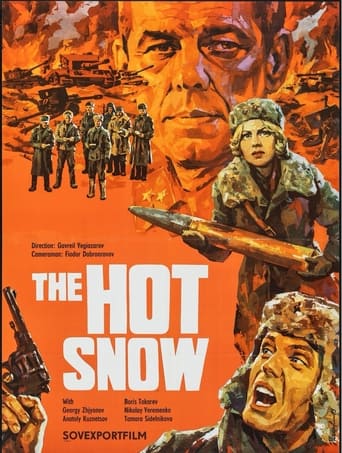gennadylevitsky
To all those folks who know about battle of Stalingrad from the Beevor's books and movie "Enemy at the Gates" this movie is must. The person who wrote the screenplay himself was artillery officer and participated in the same exact battle this movie depicts. Therefore it very likely that despite of the several shortcomings (like participation of Tiger tanks in the battle) and a little bit of propaganda (like appearance of the political commissar who, unlike stern and often unfair general, always acts humanly) the movie shows the battle the way he saw it himself. As a side note: some primitive people don't understand what the word "propaganda" means and how it works and therefore claim that every Soviet movie is a lie. I am sorry for you.
gordonl56
Goryachiy sneg (The Hot Snow) 1972This Soviet era war film tells the tale of the Red Army's defence against the German attempt to relieve the encircled Army at Stalingrad.The film follows the men of an anti-tank gun battery that is right in the center of the action. We have the standard stock Russian characters, the stoic General, the father like Political Commissar, the thoughtful peasant and the brash new officer. Throw in a female medic and several others and we are set.Needless to say, being a Soviet film the "save the motherland' speeches are laid on thick and heavy. But these are to be expected and are dropped once the action starts. One thing Soviet film makers had, was, access to plenty of Red Army units and equipment to use as extras. The period detail is pretty good, with a fair sprinkling of decent looking mock-ups of various German armoured vehicles. (The use of hordes of Tiger tanks though is historically wrong. The first Tiger units were at this time just working up in Germany, and had not been committed to the front yet)Anyways, nitpicking aside, the battle scenes are quite well done, with plenty of oomph and fine pyrotechnics on display. The anti-tank guns are shown firing full load shells with plenty of recoil involved. One seldom sees that in films. The Russians of course manage to slow the German assault enough that the Red Army can arrive to retrieve the situation. The Germans are driven back.The survivors of the battery are all given medals and vodka for their valiant defence of the position. This one is worth a look if you are war film buff. One of the things on the plus side is that, unlike some Soviet war epics, it only has a 105 minute runtime.
Michael A. Martinez
These Soviet war epics tend to get awfully frustrating after a while. While the filmmakers have huge, almost limitless resources at their disposal, like lots of vintage tanks, equipment, Red Army personnel, and government cooperation (providing it's propaganda) - narratively, they fail to adhere to basic practices. Usually a good movie does not play all its good cards at once, but these Russian war films tend to run out of steam before the climax even comes, which ends up being either glossed over or over-shadowed by bigger and better battles earlier in the film! This film is a little more patriotic than Sergei Bondarchuk's "They Fought for their Motherland" (1975), which was set a few months prior to this film in essentially the same theater of war. The big difference is this one is set in the winter and follows a much larger division of younger Anti-tankers, these ones armed with artillery instead of just PTRD rifles. While there's more action and less emphasis on mid-battle philosophizing and humanizing, and some laughable attempts to make the Political Commissars look heroic, trust and beloved by their units, this one is surprisingly short and straight-forward.The Germans attempt the near-hopeless 'Operation Winter Storm' to break out the beleaguered Sixth Army at Stalingrad. Somehow, we're asked to sympathize with the relatively well-armed Russians who are pre-ordained to win no matter what, especially since their resistance was nullified by Zhukov's 'Operation Little Saturn' which hit the German / Italian flanks and forced them to break off the attack (see the movie ATTACK AND RETREAT) which pretty much ended any hope of German victory. The soldiers pretty much just do their job as instructed besides a young lieutenant who goes through a lot of romantic angst with his girlfriend assigned to his command. A few of the main characters are killed by the anonymous Germans, who are never clearly seen save for a P.O.W.The German tanks however, with fine mock-ups of Panzer IV's, STUG III's, and even a few Tigers, are well-done and numerous, but where's the air suppport?
Dada_Tonya
Hi !This film title means "Burning snow" and this is a story of Soviet artillery soldiers who broke German tank divisions' rescue operation for besieged German army in Stalingrad, on account of their own lives.This is a rare purely combat-focused Soviet film where Stalin and top red army generals are never appeared. Even the commanding red army general on the spot is not named.In such a sense, this film is a bit closer to American war film which always focused on ordinary individual soldiers. Also camera work on this film is excellent and piling up the scenes to the climax of battle.
Also actor Boris Tokarev showed his excellent play on his roll of Lieutenant Kuznezov and he symbolized feeling of sadness of war without such words from his mouth.I believe that Boris Tokarev was one of the most favourite soviet actor specially by young females during 1970s.


